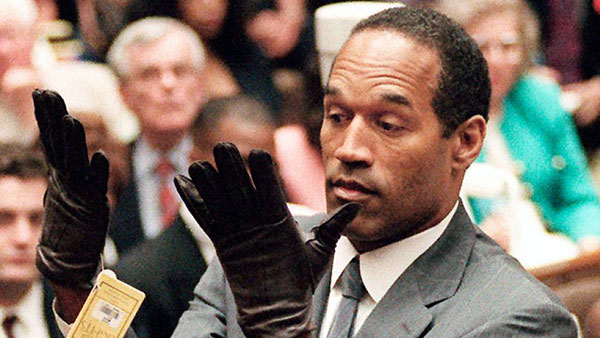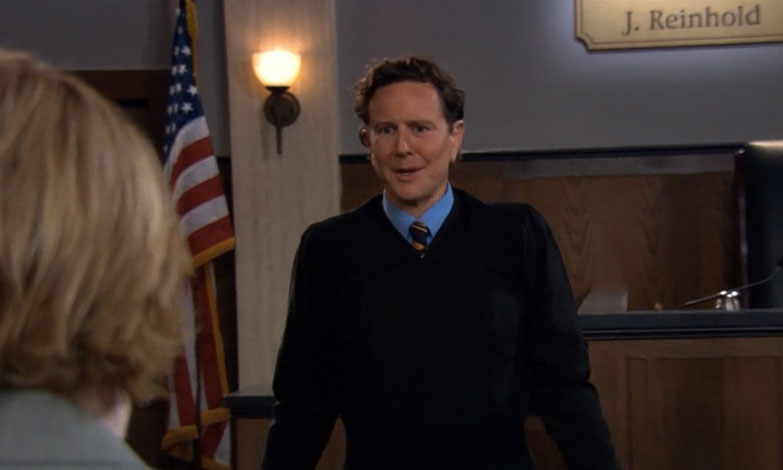Tell It To The Judge
Since the dawn of television, court shows—whether actually based on real life or heavily dramatized—have become a cheap, sustainable viewing staple.

1995: The year we reached peak courtroom
Two decades ago, you were way more likely to spot a real-life soap opera on television than you were an episode of One Life to Live. Throughout late 1994 and most of 1995, networks would pre-empt their soap operas for the "Trial of the Century"—the O.J. Simpson murder trial, a trial that took place for nearly a year.
The bearded judge Lance Ito, who allowed the cameras in the courtroom, became a celebrity in his own right, inspiring Jay Leno to create a troupe of "dancing Itos." Lawyers like Marcia Clark and Johnnie Cochran became bankable celebrities, and many of the lawyers who took part in the case became increasingly tied to celebrity culture after the trial, whether through TV appearances or in taking celebrity-tied cases. (A notable exception to this: Innocence Project lawyers Barry Scheck and Peter Neufeld, who were on Simpson's defense team, mostly kept their focus on DNA-related cases following the trial.)
And 20 years ago this week, another event that eventually, and tragically, drew cameras to courtrooms—the bombing of the Alfred P. Murrah Federal Building in Oklahoma City—took place. That trials of Timothy McVeigh and Terry Nichols didn't air live for months at a time like Simpson's trial did. But the ensuing trials may have had a more significant effect—because, thanks to the work of the victims' families, a federal law passed allowing the usage of cameras in federal courtrooms.
The reason was practical—with the trial being held in Denver, local OKC residents didn't want to have to drive hundreds of miles to see the trial in person—but it nonetheless highlighted the fact that televised court cases had become expected by the American public.
1995 wasn't the year that Court TV started, but (apologies to the Menendez brothers) it perhaps was the year that Court TV started to matter. Eventually, it could be argued, the network's success was ultimately its undoing—why do we need a dedicated network for real-life court cases when HLN is doing just fine giving Scott Peterson the obsessive analysis we've come to expect?
Courtrooms: A cheap, efficient TV format
It's worth arguing that the Simpson case—from Bronco chase to verdict—was the last hurrah of the "big television moment," the kind of thing that kept people glued to their televisions for months on end, without being sucked into the many cultural niches we have now.
But court shows have largely managed to transcend the niche culture and remain firmly in the mainstream. Why is that? A couple things: One, it's a format everyone knows, and two, the shows are cheap to produce. Judge Joe Brown and Judge Alex can fill up a lot of airtime without requiring writers or paid actors surrounding them. Even if they're ratings suck, they still come out ahead.
Oh, and one other thing: You're guaranteed conflict and resolution, which makes it perfect television.
"The disputes are not really small. The amount of money might not be small, but you could sue for a million dollars—because a million dollars are involved—but the same principles of law are involved there as with a case involving 75 cents."
— Judge Joseph Wapner, discussing his philosophy in dealing with the small-claims court cases he handled as the primary judge on The People's Court during the '80s and early '90s. Wapner, who served as a judge in the state of California prior to his television career, was not the first member of his family to appear on a court show: His father, Max Wapner, was a lawyer on the original version of Divorce Court, which aired from 1957 to 1962. (Yes, the original version of that show used actual lawyers.) Wapner, by the way, is still alive and kicking at age 95!
Five facts you didn't know about The People's Court
- Longtime People's Court host Doug Llewelyn may have largely disappeared from the TV airwaves—replaced by TMZ founder Harvey Levin, who still hosts the show despite running one of the internet's most important websites—but he also had some music video credits to his name. He was the announcer in Nirvana's "In Bloom" video, and also starred in a Weird Al video, arm-in-arm with a sumo wrestler.
- Rusty Burrell, like Wapner, actually had a longtime background in the California court system. Burrell was a bailiff on some high-profile cases, such as the trials of Charles Manson and Patty Hearst. Burrell often worked with Wapner—and also spent some time on Divorce Court.
- Late New York City mayor Ed Koch hosted the show for two years in the late '90s, making him the only former People's Court host to host Saturday Night Live … oh, and run a major city.
- Judge Judy's husband, Jerry Sheindlin, hosted the show after Koch—which we're assuming made for a weird couple of years in the Sheindlin household.
- Marilyn Milian, the current host of the show, has been on the air longer than Wapner has. She came up from the Florida court system, and had been appointed to her role by Janet Reno in the '90s. She may no longer be an actual judge, but she still has close ties to her former circuit—because her husband has her old job.
$10M
The cost to produce a season of Judge Judy each year, not factoring in the yearly salary of Judge Judy Sheindlin. Despite the judge's massive salary—she recently renewed her contract, but her prior $47 million salary made her the highest paid star on television in 2013—the show is a massive moneymaker for CBS Television, driving over $200 million in revenue yearly.

How close are dramatized courtroom scenes to the real thing?
During the final season of Arrested Development—in an episode produced at a point when the show's creators knew the series was about to get canned—there was a pretty epic meta-commentary on court shows, which featured the actor Judge Reinhold getting all diva-like about the name of the show (he didn't want to be called a judge in the series), as well as a house band called William Hung and the Hung Jury.
It was one of the better gags in the series—and a great reminder that courtroom scenes in television shows probably aren't actually like the real thing—no matter what Law and Order or Matlock might suggest.
But how far off is it, really? Fortunately, this question has come up recently. Last September, the American Bar Association covered this topic at their annual meeting, and the panelists hit on a few key points:
There's a lot less bending of the law than you think: University of Maryland law professor Taunya Lovell Banks suggests that ethics are a lot more important than many shows imply. “One of my biggest problems with a lot of the shows is that there are never any consequences when lawyers act in unethical ways,’’ Banks explained. “I find myself having to spend the first five minutes of my class—especially my first-year class—saying: ‘you cannot do this; if you do this you will lose your license.’”
Good drama doesn't make good law: Richard Sweren, a onetime criminal defense lawyer and current writer for the Law and Order franchise noted that, even with his legal background, he ultimately has to focus less on the law, and more on the plot. "I had to put my legal education, and ethical … all that aside," he explained. "What makes the best drama? That's what counts."
Legal dramas influence our perception of the courtroom: NYU Law School Senior Fellow Thane Rosenbaum, who moderated the panel, noted that the law often defines the way that we think of what happens in the justice system. It's a little more complicated than that, however. “People want to believe that the law not only can provide moral outcomes but that it can discover the truth and that the truth is ultimately the most important thing,” Rosenbaum said.
In case this topic fascinates you more, you'll be happy to know that there's a new book out on the topic. Justice Performed: Courtroom TV Shows and the Theaters of Popular Law, by author Sarah Kozinn, researches the production methods used by various legal shows—reality and otherwise. It's a justifiable read.
Before we go, we have a bit of an announcement about Tedium. As you probably know, the newsletter was an outgrowth of ShortFormBlog, the breaking news site I ran before jumping into the newsletter game.
More than a few people missed the site, so I considered a new strategy: Tedium's got a Tumblr. It won't be focused on news so much as interesting things happening online, with an eye towards the obscure and some sneak peeks of the newsletters. I'm still considering launching a full-on newsletter archive, but that's still a bit off.
Until then, enjoy the snark. And by the way, get your friends to subscribe to the newsletter. Tell them it's weird.
:format(jpeg)/2018/11/vt82jbnqzhlqlvofrj6f--1-.gif)
/2018/11/vt82jbnqzhlqlvofrj6f--1-.gif)

/uploads/ernie_crop.jpg)